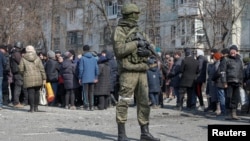Officials from Russia and Ukraine said they have agreed on a temporary cease-fire in the besieged southeastern port city of Mariupol to allow civilians to evacuate and humanitarian aid to enter.
The city has borne the brunt of Russia’s invasion, with much of Mariupol destroyed by artillery and rocket attacks. Previous attempts to help civilians through humanitarian corridors in the country have mostly failed but the March 31 announcement comes as the war continues to shift gears.
Ukrainian forces have begun retaking some Russian-controlled areas, just as Moscow said it would scale back operations around Kyiv and the northern city of Chernihiv. U.S. and Ukrainian officials say the repositioning of forces is part of Moscow’s effort to refocus toward the eastern Donbas region and an intention to refit and resupply troops.
As Russian forces regroup and readjust their goals in Ukraine, President Vladimir Putin signed a decree on March 31 ordering 134,500 new conscripts into the army as part of the country’s annual spring draft. The class of conscripts could potentially provide new forces for Russia, although their involvement in the war is highly sensitive. Moscow had previously said only professional soldiers and officers had been sent to fight in Ukraine, but the Russian Defense Ministry later acknowledged that some conscripts had been deployed.
RFE/RL spoke with retired U.S. Army Major John Spencer, chair of Urban Warfare Studies at the Madison Policy Forum and author of Connected Soldiers, to find out more about the current situation.
RFE/RL: Russia announced some sort of pullback of forces around Kyiv and previously said that the first phase of the war was over. Maps show they were already losing ground in those areas and there continues to be some fighting. So, how should we view this pullback? Is this truly voluntary? Is it meant to give Russia time to regroup or something else?
John Spencer: I think we should all view it for what it is -- a failure of Russia to achieve what it wanted to do -- which was from day one to quickly get into Kyiv and remove President [Volodymyr] Zelenskiy and install a new government to make Ukraine essentially part of the Russian Federation.
[That failed], so Plan B was just to isolate [Kyiv] and then that failed. Plan C was to hold [the area] for a while, and that failed. What we're seeing now is clearly Plan D, which is to make a message saying that that was never the goal [and] we're going to move [and] reposition [forces] to the Donbas, which would take weeks [to do], to be honest. This should be viewed for what it is, which is the success of the Ukrainian people in defending Kyiv.
RFE/RL: It seems that Russia is planning to focus its attention toward the east and southeast. Given what you’re seeing, can Russia achieve what appear to be its new goals and what many analysts have theorized about, which is a land bridge connecting Crimea, likely through Mariupol and also gaining the full territory in Luhansk and Donetsk that the separatists claim? What does this actually mean practically on the ground?
Spencer: Again, let’s call it what it is. There’s been a reduction in the objectives from Russia.
You could take those forces that are in the northern part of Ukraine [and] pull them back and move them into the eastern front. But you can't do that next week. You can't do it two weeks from now. For one, just to drive from Kyiv to Luhansk or Donetsk would take you days, and your vehicles would break down and we've already seen that [the Russian military] is logistically incompetent.
But these [Russian] forces have also been engaged in hard combat for a month.
Their casualty rates are high. Their morale is low. Their equipment is bad, they're frozen. Yes, it's possible, and this is not the end of this war, clearly, but that would take weeks [to do] properly.
There are also issues with conscripts’ [timelines] running out very quickly, and the [Russian forces] will have to possibly integrate other conscripts [into their forces], which is a nightmare as a military organization to do.
So, I say "no," it's not possible just to rapidly reposition those forces and integrate them into any type of fight in the Donbas, which also has one-third of the Ukrainian military fighting [there] as a coherent, hard fighting unit. You can't just throw those [troops] in as reserves into the fighting that's going on there.
Could you eventually do it? Yes. Pull them back into Belarus, [or] pull them back into Russia, [and then] reconstitute, refit, rearm, and reorganize them all and then push them back into [Ukraine] in a month from now? Maybe.
RFE/RL: In the meantime, it does seem that Russia's strategy is to keep a distance and we see that with intense shelling and rocket attacks. There has been lots of talk about Moscow invoking a “Chechnya” or “Syria” playbook in Ukraine, which means essentially leveling cities. Do you think that Russia is following the strategies it used in Chechnya and Syria or is it doing something different in Ukraine?
Spencer: I think it's something different. Having studied urban warfare and studied both battles of Grozny in both Chechen wars and all the Syrian battles, you have to look at it through [the lens] of the political objectives. You believe what [Moscow] does, not necessarily what it says, and we can see here that this is the product of its objectives in Ukraine changing.
[Starting] on day one, the objective was Kyiv, so you had to view all operations as in support of that objective. Now you have to look at everything in view of the new objective of taking the east. Whether it’s a land bridge through Mariupol up into the Donbas or something else, I think the shelling is just in support of eventually what will be a repositioning or a withdrawal of Russian forces from where they currently sit, and the shelling is to keep Ukrainian forces occupied.
You can't reposition Ukrainian forces at this moment. All the cities are still under threat and it is normal to bomb in support of what we call retrograding, which is pulling back to fight somewhere else. That is normal in war. Of course, Russia is committing war crimes [in the way] they're doing it, but I think the [artillery] is in support of this new objective [for Russia].
RFE/RL: Where do you think the repositioning might take place? Wherever Russia is repositioning its forces, it still looks to be trying to keep its distance and is avoiding close combat or anything that would be street-to-street fighting. So where does that leave Russia in the upcoming weeks?
Spencer: I think they're going to concentrate, unfortunately, on the massacre that is Mariupol, where it is a close-quartered fight at this point.
You can't bomb urban areas into submission. You can't even bomb entrenched soldiers into submission. Military history proves that you have to eventually close the distance and take what you want. They're in a close fight in Mariupol [and] that close fight could last for weeks.
Keeping their distance [is] normal for militaries to do, in a way it’s just common sense. But if you're going to take something from somebody, you have to close the distance and eventually go in like we're starting to see in Mariupol today [and] that I think we're going to continue to see.
[Russia] would like to get reinforcements and resupply the southeastern fight. If they really want that objective of connecting the separatist areas [to Crimea] and pushing back the Ukrainian military and [that] being what they’re able to negotiate as their win, that's still a tough fight that [they will] have to close the distance for.
RFE/RL: With all that in mind, to what degree can fighting on the battlefield decide the end of this war? Or is it ultimately going to end in a negotiating room somewhere?
Spencer: All wars are politics by other means. This ends with a political solution; it doesn't end with either side destroying the other enemy force. That's just not the way war works across time.
I don't think we're anywhere near the fighting being done. If you look at the red dots on the map, that's a lot of red. That's a lot of Russian forces sieging urban areas still. [Russian forces] are being attacked, they're taking high casualties, and that's going to continue even if there isn't a political settlement that creates a cease-fire, which I honestly, don't think is in the near-term future.
So, there's a lot of fighting that’s still going to happen.













